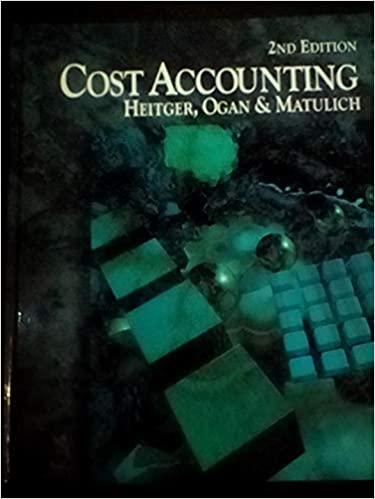Determining standard costs for budgeting purposes CPC Corporation manufactures large diameter concrete pipe for use in storm
Question:
Determining standard costs for budgeting purposes CPC Corporation manufactures large diameter concrete pipe for use in storm drains and sewers. It has operated for a number of years at the same location, and demand for its products has grown steadily because of product quality and the company's reputation for reliable production and timely delivery on contracts. The company has been turning down orders due to limited production capacity, which it cannot expand due to lack of space. Management is sure that if the company could increase production by several times, all of its products could be sold.
The company is presently negotiating a large order for its 36 inch diameter storm drain pipe. Present capacity is 500 units per day, limited by the fact that there is space enough to work with 500 molds and each pipe casting requires one day of curing time before it can be removed from the mold. Additional curing time then takes place for six days in a curing yard whose capacity is limited to production of about 1,600 units per day.
Production of 500 units requires 15 employees working 8 hours a day at $8 per hour. Each pipe requires 6 cubic feet of concrete costing $11 per cubic foot. Overhead is estimated at $5 per direct labor hour. The selling price per unit is to be determined by contract negotiations, and management feels the company can be competitive at $95 per unit. Administrative expenses are $75,000 per month and the company is subject to a 30 percent tax rate.
In order to decide how to bid on the 36-inch pipe contract, the company's vice president for production started to investigate the possibility of increasing production by changing the produc- tion process. Two possibilities emerged that may enable the company to increase production. Both warrant investigating because the contract under consideration is very large and could keep the company busy most of the year even if production capacity were increased fourfold. What- ever portion of the pipe order CPC Corporation cannot produce will be lost to competitors.
One alternative is to switch production to a steam curing process. Curing time would be reduced to about 6 hours and would permit the company to employ its 500 molds three times in each 24 hour period. However, to handle the steam equipment and higher production volume the labor force would have to be increased from 15 to 54 employees who would work in three shifts of 18 employees each. The second shift would have to be paid $11 per hour and the third shift $14 per hour. In addition, the cost of steam is expected to be $504 per day, and the lease cost of the steam generating equipment would add $2 per direct labor hour to overhead cost.
The second alternative would also triple daily production and would require operating three shifts of 16 employees each. No new equipment would be required. Instead, the company would add to its concrete a newly developed chemical additive that causes extremely rapid curing. The cost of the chemical would be $4.40 per unit of product. The same labor rates would be incurred as with steam curing, but the overhead rate would remain at $5 per direct labor hour. In all cases the company would operate 20 days per month.
Neither of the proposed alternatives is expected to increase the $75,000 monthly administra- tive expense.
REQUIRED
a. Calculate the standard cost of the product with the current production process.
b. Calculate the standard cost of the product using the steam-curing process.
c. Calculate the standard cost of the product using the chemical additive process.
d. Calculate the expected net income after tax with each production process.
e. Calculate the after-tax return on sales for each production process.
f. Discuss which alternative the company should adopt.
Step by Step Answer:






